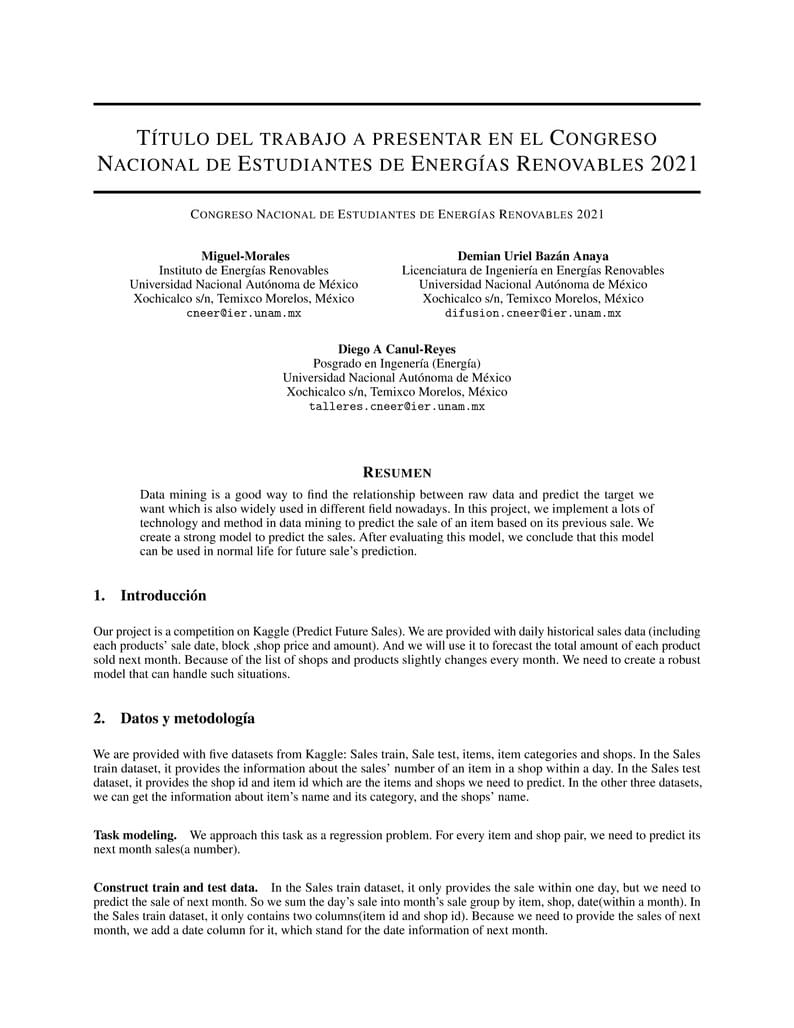
Plantilla trabajos CNEER2021

% Plantilla basada en "Style and Template for Preprints (arXiv, bio-arXiv)"
\documentclass{article}
\usepackage{arxiv}
\usepackage[utf8]{inputenc} % allow utf-8 input
\usepackage[T1]{fontenc} % use 8-bit T1 fonts
\usepackage[hidelinks]{hyperref} % hyperlinks
\usepackage{url} % simple URL typesetting
\usepackage{booktabs} % professional-quality tables
\usepackage{amsfonts} % blackboard math symbols
\usepackage{nicefrac} % compact symbols for 1/2, etc.
\usepackage{microtype} % microtypography
\usepackage{lipsum} % Can be removed after putting your text content
\usepackage[spanish,mexico]{babel} %let write in spanish and with decimal point
\usepackage{graphicx}
\usepackage{adjustbox}
\usepackage{amssymb, amsmath, amsbsy, amsfonts}
\usepackage{hyperref}
\usepackage{listings}
\usepackage{multirow}
\usepackage{multicol}
\usepackage{arydshln}
\graphicspath{{Figuras/}}
\title{Título del trabajo a presentar en el Congreso Nacional de Estudiantes de Energías Renovables 2021}
%\date{September 9, 1985} % Here you can change the date presented in the paper title
\date{} % Or removing it
\author{
Miguel-Morales \\
Instituto de Energías Renovables\\
Universidad Nacional Autónoma de México\\
Xochicalco s/n, Temixco Morelos, México \\
\texttt{cneer@ier.unam.mx} \\
%% examples of more authors
\And
Demian Uriel Bazán Anaya \\
Licenciatura de Ingeniería en Energías Renovables\\
Universidad Nacional Autónoma de México\\
Xochicalco s/n, Temixco Morelos, México \\
\texttt{difusion.cneer@ier.unam.mx} \\
\And
Diego A Canul-Reyes \\
Posgrado en Ingenería (Energía)\\
Universidad Nacional Autónoma de México\\
Xochicalco s/n, Temixco Morelos, México \\
\texttt{talleres.cneer@ier.unam.mx} \\
%% \AND
%% Coauthor \\
%% Affiliation \\
%% Address \\
%% \texttt{email} \\
%% \And
%% Coauthor \\
%% Affiliation \\
%% Address \\
%% \texttt{email} \\
%% \And
%% Coauthor \\
%% Affiliation \\
%% Address \\
%% \texttt{email} \\
}
\begin{document}
\maketitle
\begin{abstract}
Data mining is a good way to find the relationship between raw data and predict the target we want which is also widely used in different field nowadays. In this project, we implement a lots of technology and method in data mining to predict the sale of an item based on its previous sale. We create a strong model to predict the sales. After evaluating this model, we conclude that this model can be used in normal life for future sale’s prediction.
\end{abstract}
% keywords can be removed
%\keywords{First keyword \and Second keyword \and More}
\section{Introducción}
Our project is a competition on Kaggle (Predict Future Sales). We are provided with daily historical sales data (including each products’ sale date, block ,shop price and amount). And we will use it to forecast the total amount of each product sold next month. Because of the list of shops and products slightly changes every month. We need to create a robust model that can handle such situations.
\section{Datos y metodología}
\label{sec:headings}
We are provided with five datasets from Kaggle: Sales train, Sale test, items, item categories and shops. In the Sales train dataset, it provides the information about the sales’ number of an item in a shop within a day. In the Sales test dataset, it provides the shop id and item id which are the items and shops we need to predict. In the other three datasets, we can get the information about item’s name and its category, and the shops’ name.
\paragraph{Task modeling.}
We approach this task as a regression problem. For every item and shop pair, we need to predict its next month sales(a number).
\paragraph{Construct train and test data.}
In the Sales train dataset, it only provides the sale within one day, but we need to predict the sale of next month. So we sum the day's sale into month's sale group by item, shop, date(within a month).
In the Sales train dataset, it only contains two columns(item id and shop id). Because we need to provide the sales of next month, we add a date column for it, which stand for the date information of next month.
\subsection{Headings: second level}
\lipsum[5]
\begin{equation}
\xi _{ij}(t)=P(x_{t}=i,x_{t+1}=j|y,v,w;\theta)= {\frac {\alpha _{i}(t)a^{w_t}_{ij}\beta _{j}(t+1)b^{v_{t+1}}_{j}(y_{t+1})}{\sum _{i=1}^{N} \sum _{j=1}^{N} \alpha _{i}(t)a^{w_t}_{ij}\beta _{j}(t+1)b^{v_{t+1}}_{j}(y_{t+1})}}
\end{equation}
\subsubsection{Headings: third level}
\lipsum[6]
\paragraph{Paragraph}
\lipsum[7]
\section{Resultados}
\label{sec:others}
\lipsum[8] \cite{kour2014real,kour2014fast} and see \cite{hadash2018estimate}.
The documentation for \verb+natbib+ may be found at
\begin{center}
\url{http://mirrors.ctan.org/macros/latex/contrib/natbib/natnotes.pdf}
\end{center}
Of note is the command \verb+\citet+, which produces citations
appropriate for use in inline text. For example,
\begin{verbatim}
\citet{hasselmo} investigated\dots
\end{verbatim}
produces
\begin{quote}
Hasselmo, et al.\ (1995) investigated\dots
\end{quote}
\begin{center}
\url{https://www.ctan.org/pkg/booktabs}
\end{center}
\subsection{Figures}
\lipsum[10]
See Figure \ref{fig:fig1}. Here is how you add footnotes. \footnote{Sample of the first footnote.}
\lipsum[11]
\begin{figure}
\centering
\fbox{\rule[-.5cm]{4cm}{4cm} \rule[-.5cm]{4cm}{0cm}}
\caption{Sample figure caption.}
\label{fig:fig1}
\end{figure}
\begin{figure} % picture
\centering
\includegraphics[scale=0.5]{SolarPark.jpg}
\caption{Parque Solar Meuro en Alemanio. Imagen obtenida de \textit{en.wikipedia.org}}
\end{figure}
\section{Discusión}
\label{sec:others2}
\lipsum[15] \cite{kour2014real,kour2014fast} and see \cite{hadash2018estimate}.
\subsection{Tables}
\lipsum[12]
See awesome Table~\ref{tab:table}.
\begin{table}
\caption{Sample table title}
\centering
\begin{tabular}{lll}
\toprule
\multicolumn{2}{c}{Part} \\
\cmidrule(r){1-2}
Name & Description & Size ($\mu$m) \\
\midrule
Dendrite & Input terminal & $\sim$100 \\
Axon & Output terminal & $\sim$10 \\
Soma & Cell body & up to $10^6$ \\
\bottomrule
\end{tabular}
\label{tab:table}
\end{table}
\subsection{Lists}
\begin{itemize}
\item Lorem ipsum dolor sit amet
\item consectetur adipiscing elit.
\item Aliquam dignissim blandit est, in dictum tortor gravida eget. In ac rutrum magna.
\end{itemize}
\bibliographystyle{unsrt}
\bibliography{references} %%% Remove comment to use the external .bib file (using bibtex).
%%% and comment out the ``thebibliography'' section.
%%% Comment out this section when you \bibliography{references} is enabled.
\end{document}